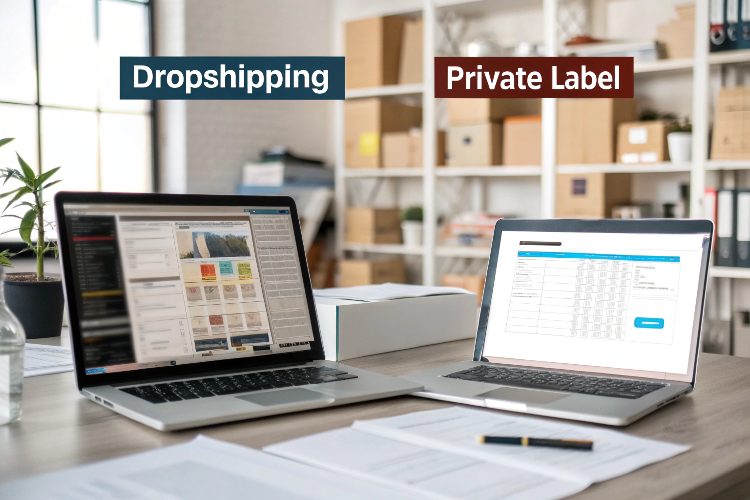Blog
Dropshipping vs. Private Label: Which Business Model is Best?
E-commerce & Online Business ▪ 2025-03-10

Starting an e-commerce business in 2025 presents entrepreneurs with various business models, two of the most popular being dropshipping and private labeling. Both models offer unique advantages and challenges, making it essential to understand their differences to determine which is best suited for your business goals.
This guide will explore dropshipping vs. private label, compare their pros and cons, and help you decide which model is best for your e-commerce business.
What is Dropshipping?
Dropshipping is a low-risk e-commerce business model where an online retailer sells products without holding inventory. Instead, the store purchases items from third-party suppliers, who then ship the products directly to customers.
How Dropshipping Works
-
A customer places an order on your online store.
-
You forward the order to a dropshipping supplier.
-
The supplier ships the product directly to the customer.
-
You earn a profit from the price difference.
Pros of Dropshipping
✅ Low Startup Costs – No need to invest in inventory or warehousing.
✅ No Inventory Management – Suppliers handle storage and shipping.
✅ Wide Product Selection – Easy to test and switch products without financial risk.
✅ Scalability – Quickly add new products and expand your store.
✅ Location Independence – Can be managed from anywhere with an internet connection.
Cons of Dropshipping
❌ Lower Profit Margins – Since suppliers control pricing, margins are thinner.
❌ Less Control Over Quality – Product quality and delivery times depend on suppliers.
❌ Longer Shipping Times – Especially when sourcing from overseas suppliers like AliExpress.
❌ Intense Competition – Many stores sell the same products, making differentiation difficult.
❌ Limited Branding Opportunities – Since you don’t control the product, branding is minimal.
Best Dropshipping Platforms & Suppliers
-
AliExpress (China-based suppliers, ideal for global dropshipping)
-
SaleHoo (Verified supplier directory for better quality control)
-
CJ Dropshipping (Faster shipping times and product customization)
-
Spocket (Focus on U.S. and European suppliers)
-
Zendrop (Automated dropshipping platform with branding options)
What is Private Labeling?
Private labeling is a custom branding business model where a retailer partners with manufacturers to create custom-branded products. The retailer controls product quality, branding, and packaging while the manufacturer produces the goods.
How Private Labeling Works
-
You partner with a manufacturer to produce products under your brand.
-
Products are customized with your brand logo, packaging, and specifications.
-
You stock inventory in a warehouse or use a fulfillment service (e.g., Amazon FBA).
-
Customers purchase products from your online store.
-
Orders are shipped directly from your warehouse or fulfillment center.
Pros of Private Labeling
✅ Higher Profit Margins – Since you control pricing, you can set higher profit margins.
✅ Brand Ownership – Establish a unique, recognizable brand.
✅ Better Product Quality Control – Customize products to meet customer needs.
✅ Increased Customer Loyalty – Branded products encourage repeat purchases.
✅ Faster Shipping – When using local manufacturers or fulfillment centers like Amazon FBA.
Cons of Private Labeling
❌ Higher Startup Costs – Requires upfront investment in inventory and branding.
❌ Inventory Management – Products need storage, leading to warehouse costs.
❌ Risk of Unsold Inventory – If a product doesn’t sell, you may incur losses.
❌ Longer Production Times – Custom manufacturing takes time before products are market-ready.
Best Private Label Suppliers & Platforms
-
Alibaba (Wholesale manufacturers for private label production)
-
Printful (On-demand private labeling for apparel and accessories)
-
Gooten (Print-on-demand private labeling for custom products)
-
ThomasNet (USA-based manufacturers for better quality control)
-
Amazon FBA (Handles inventory storage, shipping, and customer service)
Dropshipping vs. Private Label: Key Differences
| Feature | Dropshipping | Private Label |
|---|---|---|
| Upfront Investment | Low | High |
| Inventory Management | No | Yes |
| Profit Margins | Low | High |
| Branding Control | Limited | Full Control |
| Shipping Times | Longer (2-4 weeks) | Faster (Local fulfillment centers) |
| Supplier Dependency | High | Medium |
| Customer Loyalty | Low | High |
| Competition | High (Saturated market) | Moderate (Brand differentiation) |
| Risk Level | Low | Moderate to High |
Which Business Model is Right for You?
Choosing between dropshipping and private labeling depends on your business goals, budget, and long-term vision.
Dropshipping is Best If:
✅ You have a low budget and want to start with minimal risk.
✅ You want to test different products before committing to one niche.
✅ You prefer a location-independent business model.
✅ You want to scale quickly without dealing with inventory.
Private Labeling is Best If:
✅ You want to build a long-term brand with customer loyalty.
✅ You can afford higher upfront costs for product customization.
✅ You prefer higher profit margins and better pricing control.
✅ You want to differentiate from competitors with unique products.
How to Transition from Dropshipping to Private Labeling
Many successful e-commerce brands start with dropshipping to test product demand before transitioning to private labeling. Here’s how:
-
Validate Winning Products – Use dropshipping to identify high-performing products.
-
Gather Customer Feedback – Understand what customers like and dislike.
-
Find a Reliable Manufacturer – Partner with private label suppliers.
-
Customize & Brand Products – Add logos, packaging, and custom features.
-
Switch to Warehouse & Fulfillment Services – Use Amazon FBA or third-party fulfillment centers.
-
Market Your Brand Aggressively – Focus on brand awareness, influencer collaborations, and customer loyalty programs.

